

|
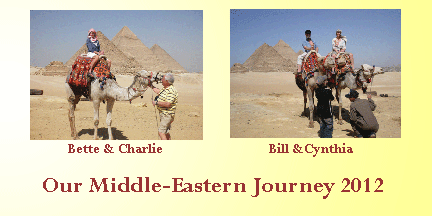 |
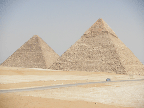
Cairo |
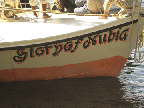
Aswan |
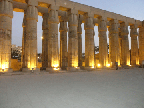
Luxor |
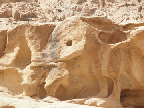
Sinai |
| As we entered the Cairo International Airport Terminal, a well-dressed young man appeared and offered, in excellent English, his help. What a gift he turned out to be! He ushered us quickly through customs, security, and baggage claim, then led us to a van waiting outside to take us to the Shepheard Hotel. He also arranged for a tour guide, who would pick us up at our hotel in the morning, a tour guide named Emid, who also turned out to be wonderful! | |||
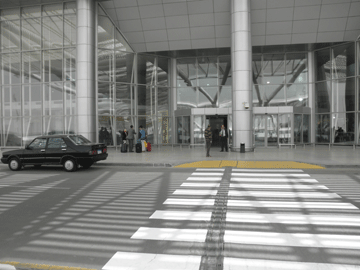
Cairo Airport |
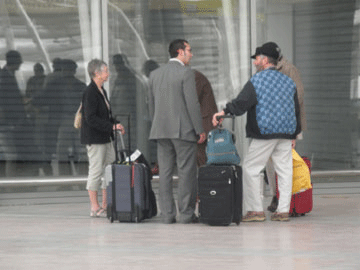
Our First Helpful Egyptian | ||
| The Shepheard Hotel, a true oasis on the Nile! Originally
named The New British Hotel, it was built in 1841 and rebuilt in 1957. It
is the same hotel Charlie stayed in thirty-four years ago, when he came
to Egypt by himself. It's also the same hotel Mark Twain stayed in and complained
about in Innocents Abroad. This old hotel has all the amenities:
a grand staircase, spacious rooms, formal dining room and bar, great chandeliers,
and WiFi. The Hotel is bordered on the left by the Nile, the only place in the neighborhood that was here when Charlie and Mark Twain visited. Now, across the street, blocking the sun, is a massive Intercontinental Hotel, and on the right is tank-lined Embassy Row. The first building on that street houses the Embassy of the United States, and it is guarded by armored tanks and army trucks with armed soldiers on top. A group of soldiers on the street hold bullet-proof shields along with their machine guns. | |||
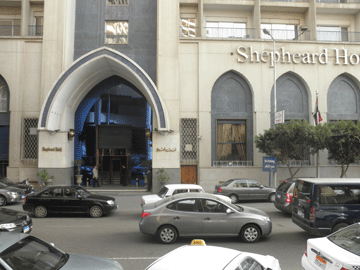
Shepheard Hotel |
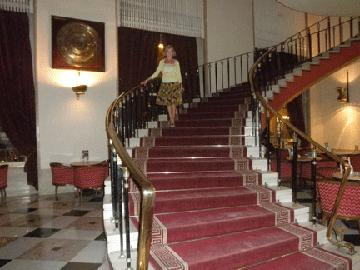
Moira's beautiful African skirt, a gift to me in Tanzania! | ||
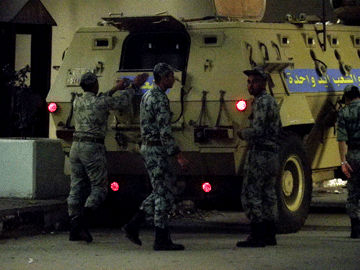 |
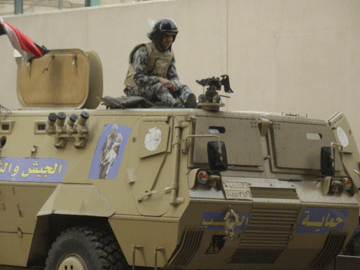 |
||
| Guarding the American Embassy | |||
| We had planned to spend our first afternoon at the Egyptian Museum, but Charlie had an intestinal bug, so we just walked along
the Nile, and down embassy row, then stopped for a glass of fine wine in the handsome hotel bar. Cynthia and Bill went to the Museum.
In the evening, wanting an authentic Egyptian dinner, Charlie ordered the taxi driver to take us to the restaurant section of the city where the local Egyptians eat. The taxi stopped and pointed down the crowded street. We got out and followed Charlie till he found his place. The oven was on the street, where I thought we would be eating our dinner, but the cook led us up a dark, narrow stairway to the second floor. At the end of the room was a table by the window, up one step from the rest of the room. We were the only customers. The wait was very long, understandable since the restaurant had only one cook and one helper. | |||
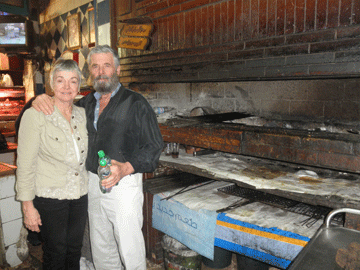
The Kitchen |
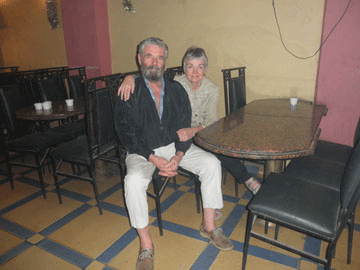
The Dining Room |
||
| When the food was ready, the helper asked us to move to
a larger table. Gathering my stuff and hurrying to move, I forgot about
the step down and fell. My lemonade soda went flying and
splashed all over the place (Moslem eating places do not serve alcohol),
and my foot twisted against the floor. The pain was excruciating. I
felt dizzy and lost my appetite. The others said the food was very good.
I slept with ice wrapped aroung my foot. In the morning I could hardly stand on it, but our guide was in the lobby and the van to take us to the pyramids was waiting at the door. Cairo. Wednesday, March 14, 2012 Emed, our wonderful guide, suggested we stop at the hospital on the way to the pyramids to have the foot checked. So, led by Emed, we stopped at the emergency room, where we met a very nice doctor, had an x-ray, found out nothing was broken, got a big picture of my x-ray and two prescriptions, picked them up at the pharmacy, and went on our way to Sakkar to see the oldest pyramid and the tombs. On the way, we passed Tahrir Square, site of the January 25, 2011 Revolution. We saw the remains of the burned building next to the Egyptian Museum. The traffic in Cairo is like nothing we have ever experienced: no lines painted on the streets, no traffic lights, no order, no pedestrian crosswalks, and cars all over the place. Emed explained that the roads in the city were built for 4 million cars and now there are 9 million. Just like in Arusha, Tanzania, Cairo has "dahla dahlas," but here they call them mini-buses (pronounced meenie-booses). Plus, like Arusha, old pick-up trucks transport several people at once. Emed said the population of Egypt is 85 million, with 24 million in Cairo, 19 million residents who actually live in Cairo, and 5 million who have come to work in the city. He also told us that 76% are Moslems, 21% Christians, and 3% Jews. In Saqqara, we saw the world's oldest pyramid, the first of the great pyramids, designed by a brilliant architect. Earlier temples were made from perishable materials, while royal tombs were usually underground rooms topped with mud bricks. This pyramid was built with hewn stone. It is being repaired now and we weren't allowed to go inside. | |||
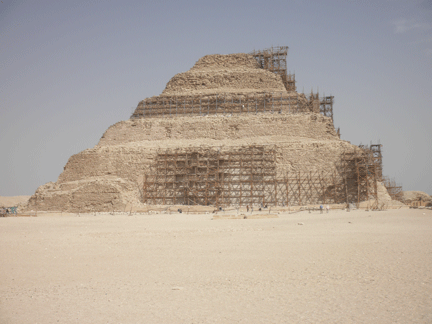 |
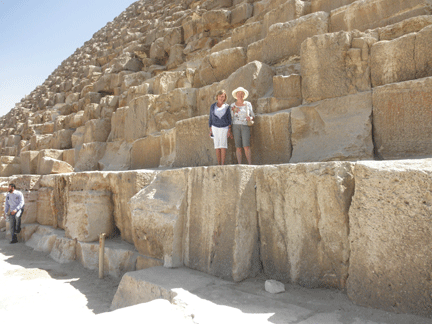 | ||
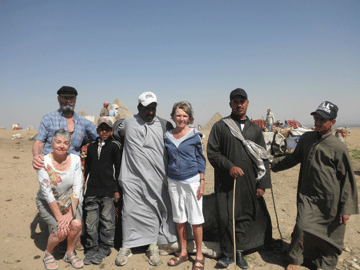 |
|||
| Desert Friends | |||
| On the way back, we stopped at the Saqqara Carpet School, where children from 10 years old learn how to make carpets. Children go to this school after their regular school day is over. It takes six months for a small group to make a carpet, and if it is sold, the children get a percentage of the sale. Bill bought two medium-size carpets, and Charlie bought a tiny table carpet. | |||
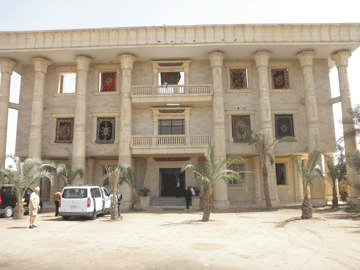 |
|||
| Saqqara Carpet School | |||
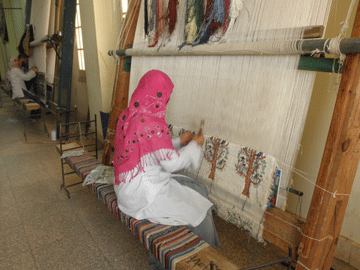 |
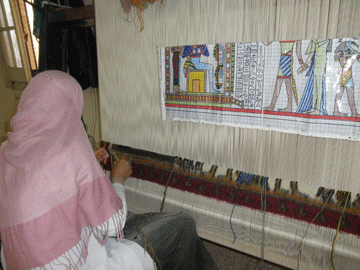 | ||
| From Saqqara, we went to Giza, and saw the three famous 4000 year old pyramids. It was earlier thought that they were made by slaves, but our guide took great pains to disabuse us of that false belief. Research has shown that workers were not slaves but a highly organized work force of Egyptian farmers, who worked on the tombs during the annual flood season when the Nile covered their fields. Also in Giza is the Sphinx from my 4th grade Egyptian unit. "Seeing the Sphinx is like meeting a TV personality in the flesh: he's smaller than one had imagained," wrote English playwright Alan Bennett. I can't agree. That old Sphinx is still awesome to me. It was a thrill to be taking his picture, even though it was the wrong time of day because a shadow fell across his nose and I couldn't get a clear picture of his face. | |||
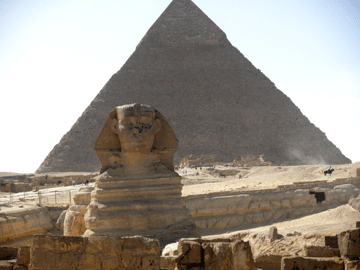 |
|||
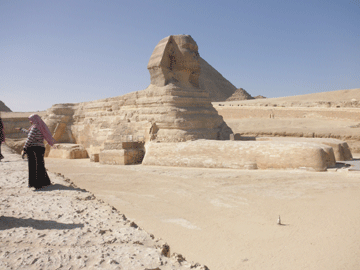 |
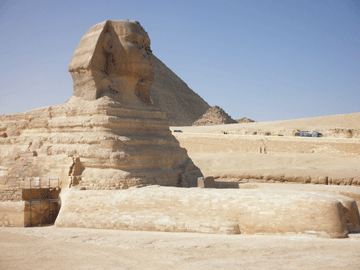 | ||
| Awesome Sphinx! | |||
| For Cynthia, Bill, and me, the biggest thrill in this wondrous place was the leisurely camel ride along the great pyramids through the Sahara Desert. Before I got on the camel, a smiling man wrapped a headscarf around my head. I kept thinking, "I'm riding on a camel in the Sahara Desert by the great pyramids!" The theme from Lawrence of Arabia was playing in my head. Charlie and Emed followed in a wagon pulled by a struggling little donkey. | |||
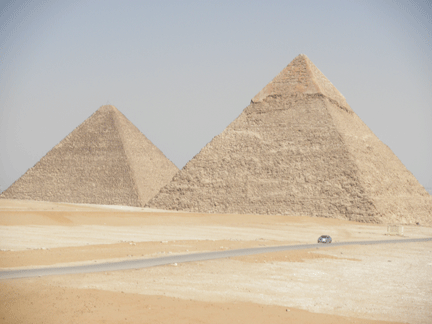
Awesome Pyramids! | |||
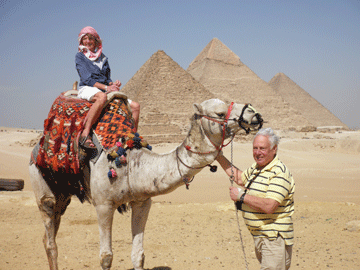 |
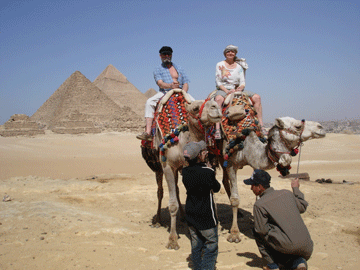 |
||
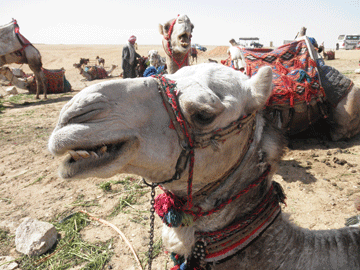 |
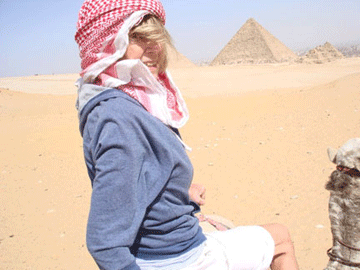 | ||
| Olli and Me | |||
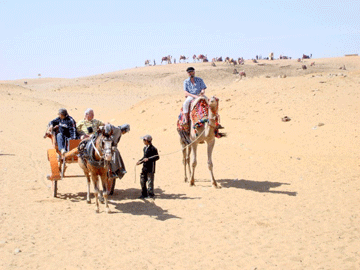
Charlie and Emed in the Donkey Wagon. Bill on the Camel. |
|||
| Back at the Shepheard Hotel after our awesome day, we were looking forward to a relaxing dinner. Charlie did not want to eat in the hotel. About a block from the hotel was a bridge over the Nile that led to restaurant boats on a dock, and that's where Charlie wanted to eat. We'd have to walk there, since the traffic situation was do dire. I didn't want to walk anywhere on that foot (although it was much better). All I wanted to do after our busy day was to stay where we were. So Charlie went off, and Cynthia, Bill and I ate in the beautiful Shepheard Hotel dining room, at a table right next to the window that looked out on the busy Cairo nightlife, people walking by, cars locked in a traffic jam, people waving to us.It was a lovely dinner. | |||
| TOP | |||
|
Aswan, Egypt. Day 1 on the Glory of Nubia felucca.
A large post-Revolution sign in the Cairo airport read"Egypt is not changing. Egyptians are doing what they've always done--making history." I liked that. After a one-hour flight from Cairo, we arrived in Aswan. We collected our baggage and I was wondering where our promised guide was, when I saw a smiling man holding a big sign that said "Welcome, Bette Tsoutsouras." It was Abdo, the Egyptian representative of Free Lancers, the travel agency that owns the Glory of Nubia. He had a van waiting to take us to our felucca. The felucca was just like I had imagined, just like the online pictures, just like we hoped it would be. We met our captain, Ooucha, and his crew, Ahmed and Mostafa. The boat is painted yellow and is 38' 4" and very attractively decorated with oriental carpets, yellow bed cushions, orange pillows and exotic Egyptian lanterns hanging all around. The only thing we didn't expect was the cool wind, which made us think we wouldn't be swimming in the Nile. We went on a short sail, and then back to the dock for our first lunch on the boat. Great bread, salad, cheese, and tea set on a tablecloth with china and silver. | ||
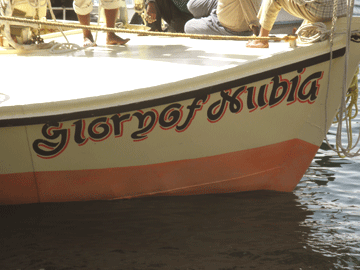 | 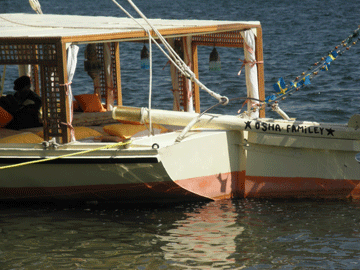 |
|
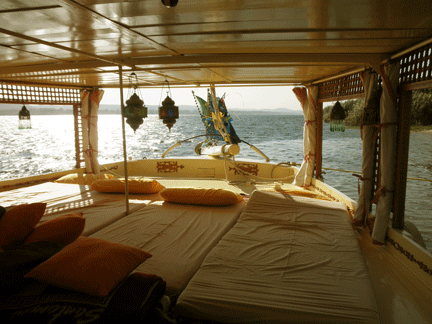 |
||
| Glory of Nubia: Dining Room, Living Room, and Bedroom! | ||
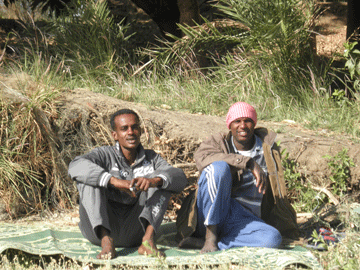
Captain Oucha and Friend |
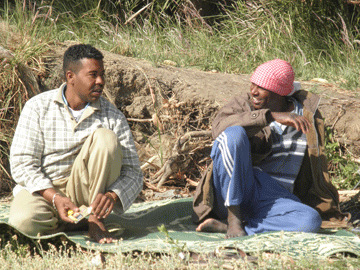
First Mate Ahmed and Friend |
|
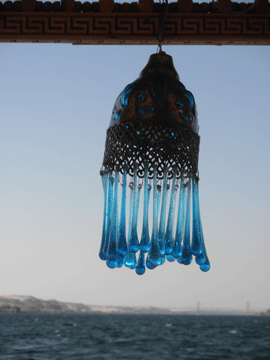
Magic Lantern | ||
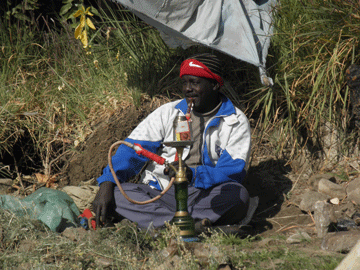
Chef Mostafa and his Chesha | 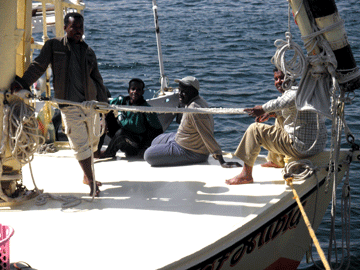
Glory Boys |
|
| After lunch we meet our guide, Mohammed, and went to the
Philae Temple, located in ancient times on the island of Philae on Lake
Nasser, Nubia. In 1902, the Aswan Low Dam was completed on the Nile River
by the British. This threatened many ancient landmarks, including the temple
complex of Philae, which was flooded most of the year. In 1960 UNESCO started
a project to try to save the buildings on the island. First of all, a large
coffer dam was built. Any water that seeped through was pumped away. Next,
the monuments were cleaned and measured, by using photogrammetry, a method
that enables the exact reconstruction of the original size of the building
blocks that were used by the ancients. Every building was dismantled into
about 40,000 units, and then transported to the nearby Island of Agilkia,
situated on higher ground 500 metres (1,600 ft) away. Isis was the main goddess of the temple complex. Her husband Osisis was murdered by his brother Seth, who then spread the body parts all over Egypt. Isis was able to locate all the parts and put them together, then conceive a son, Horus. This was the first we heard about Isis, Osisis, and Horus, but we would soon become quite familiar with this little family in our travels through the ancient Egyptian tombs. Philae was a seat of the Christian religion as well as of the ancient Egyptian faith. The ruins of a Christian church were also discovered here, so in different eras the complex served as a temple of Osiris and a chapel of Christ. | ||
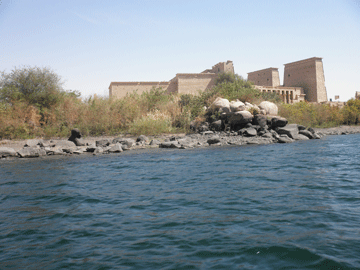
Temple Complex on the Island of Agilkia, Aswan |
||
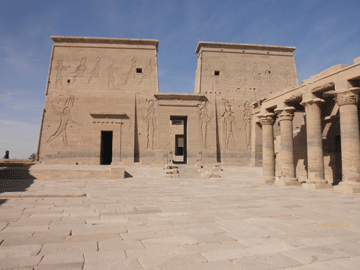 |
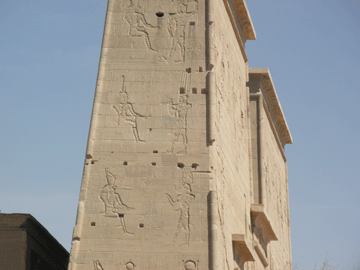 |
|
|
Back on the Glory of Nubia, we set sail up the river for our island where we would spend the night. We had dinner on the island by a campfire. After
dinner, Nubian dancers and singers arrived, and we all joined in a dance around the fire. Cynthia had the stomach bug, so she stayed on the boat. Bill,
Charlie, and I joined the dance. I tripped over the end of a log that was sticking out from the fire, and when I felt blood trickling onto my foot, I sat down and
found a nasty gouge in my left leg (the other leg was already injured in the restaurant fall). I wrapped my new sock around it and taped it on with
band aids. It was hard sleeping because I didn't want the sock to fall off, and the wound hurt a lot.
Aswan, Egypt. Day 2 on the Glory of Nubia felucca. Friday, March 16, 2012 We had to get up at 3:00 a.m. for our trip to Abu Simbel. I put folded tissues over the throbbing mess with band-aids to hold it. A motor boat picked us up on our felucca and brought us to the dock, where our van was waiting to take us on a three-hour ride through the desert. Charlie didn't go with us because he had been to Abu Simbel on his last trip. We had to go in a convoy of vehicles, gathered from all the nearby hotels and tourist groups and led by armed Egyptian soldiers. Our new guide was Mohammed, and he said the convoy was for safety and that after the Revolution, embassies had requested it. At one point on the long, deserted, desert road to Abu Simbel, Sudan was only 40 miles away. I was glad to be in the convoy. | ||
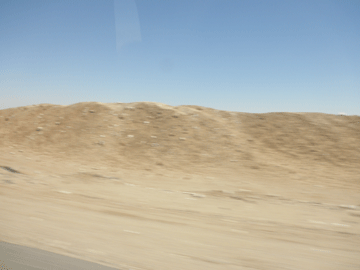
On the way to Abu Simbel. The three-hour view as we drove through the desert. |
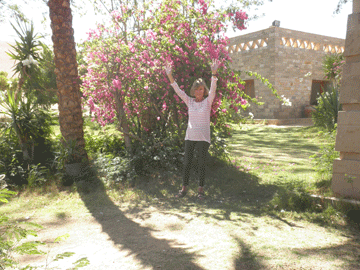
Me in Abu Simbel. I can't explain the sudden burst of energy. |
|
|
On the way, we discussed the January 25th Revolution with Mohammed, as we had with Emed, and both acknowledged the fact that after revolution
comes a period of chaos, and that Egypt is not quite over that period yet. Until a president is elected in June, there is no real government at the top,
no group making decisions and things change from day to day. The army is not running the country, but just trying to keep order and to keep people safe.
Since the Revolution, they have put up many check points and speed bumps. During the Revolution, prisoners were freed from jail, and this was also a
post-revolution way of identifying people.
Despite that, people seem hopeful, extremely proud of their Revolution and everyone we talk to is very happy to be rid of the old corrupt government of Mubarak. However, one of our guides said his father wonders why they "kicked Mubarak out," and he told us that many of his father's generation wonder also. One effect of the chaos is the extremely long lines of trucks, vans, and cars waiting to reach a gas station. We saw this all the way out of Aswan. Our guide felt that there was no real shortage of gas, that it was a fake thing. Someone might just have decided it's a good way to exert power over the people. No group is in control so one group will make a decision and the next day another group will change it. The "government" had just announced that the gas problem was solved, but the endless lines prove that it's not. Often cars and trucks will wait hours in line and get to the station and be told they're out of gas. I enjoyed our conversations with Mohammed. I asked him lots of questions, which he willingly answered. He has an eight-month old boy named Islam. He said that they lived with his wife's mother for the month after the baby was born. He also said that a man's mother comes before his wife in his respect and love. Before Mohanned married, he had to be certain that his mother would always be welcomed in their home and that his wife would love and care for her as if she were her own mother. He said when a woman marries, she joins her husband's family, while the man remains close to his mother. He also told us that in Egypt, the husband must provide the house and the furnishings for every room except the kitchen and the guest room (probably where a visiting mother-in-law resides). I asked him why so many homes were left unfinished, the top floors always looking as if they were under construction. He explained that it will be the son's home when he marries. Each time a son marries, they'll add another floor. In Abu Simbel is the great temple of Pharoh Ramses II, carved out of a mountain on the west bank of the Nile between 1274 and 1244 B.C. The temple was buried in sand until 1813 when a Swiss explorer rediscovered it with only one of the heads above the sand. Four enormous statues of Ramses at different stages of his life are at the front of the temple. Smaller statues are of the pharoh's mother, Queen Tuya, his favorite wife Nefertari, and some favorites of his 100+ children. | ||
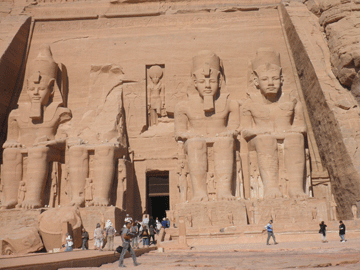
Temple of Pharoh Ramses II |
||
| Next to the great temple is a smaller one with statues of Ramses and Nefertari and some of their children. Nefertari is the same height as her husband, which is unusual since most wives portrayed in the sculptures came only came up to their husband's knees. Inside, she is also portrayed as an equal to Ramses and very beautiful. All the women pictured on the temple walls are slim and the men are muscular. No obesity problem in ancient Egypt. | ||
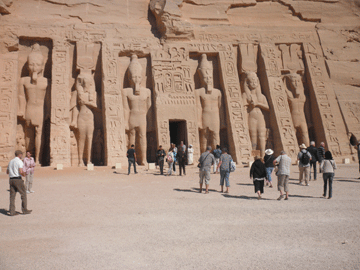
Temple of Queen Nefertari, Ramses II's Favorite Wife |
||
| We arrived back at our felucca about 1:30. Charlie had been
on a shopping spree with Abdu (the man who met us at the airport, and is
in charge of everything related to our felucca experience from Aswan to
Luxor. We saw him every day. He is wonderful!) Charlie had bought two galabias,
one for daytime wear and one for sleeping, and two Egyptian hats. He also had
picked out necklaces for Piper, Lindsey, Lily, and Laura. Each one is a
small scarab of a different color. He wanted me to see them before he bought
them. Charlie also bought me a silver cartouche with my name in hyroglyphics.
(As I was writing this on the felucca, Mostafa brought me
tea and a biscuit.) I told Charlie that I'd like to stop at a pharmacy to get something to wrap my leg in. It was still killing me. When Abdu saw it, he insisted I have it looked at the hospital. He called his wife, who knew a doctor at the hospital. She phoned the doctor, called Abdu back, and told us to meet the doctor at the hospital. So for the second time in a week, I was in an Egyptian hospital. The male nurse cleaned it and the doctor examined it, all within 20 minutes. As we stopped at the desk to pay, Abdu motioned for us to come over to him and the doctor. We handed the doctor 80 pounds (6 pounds=1 dollar). Again, we got great service inexpensively at an Egyptian hospital that in many other ways is decades behind our American hospitals. I didn't take any pictures that would show the physical differences between our hospitals and theirs because I was so grateful for the kind, generous, competent care I received from everyone in the hospital. While we were in Aswan, Abdu's wife was expecting her baby at any minute. I asked Abdu if she would go to a hospital to have the baby. He shook his head and said she would go to her doctor's clinic. Their baby was a girl and they would name her Sadn. (I don't know yet when the baby was born, but I hope to find out.) Back on the Glory of Nubia, we had a delicious meal. It was a cold evening, but we were exhausted from our long day, so I think the four of us slept very well, spread around the deck on our mattresses, with warm blankets. Our crew slept either in a crawl space under the bow or in one of the tents set up on the island. If anyone had to get up during the night, he had to find his flashlight, walk the plank from the felucca to the ground, and find the portable toilet up in the bushes. Aswan, Egypt. Day 3 on the Glory of Nubia felucca. Saturday, March 17, 2012 Sunny, but too windy to sail up the river to our destination, so we stayed where we landed the previous evening, on the West side of the Nile. We walked up a hill that rose steeply from the Nile and led to a Nubian village. There was one paved road that went around the village, and all the narrow roads going through the village were dirt. At the end of each street were pots full of water, for drinking. Some had metal cups on top. | ||
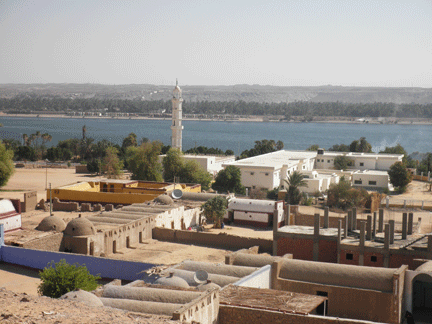
View from Nubian Villages to the Nile and Aswan | ||
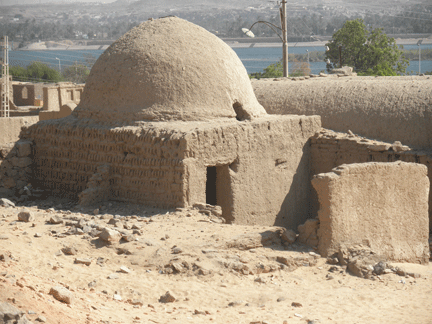
Home is where the heart is. |
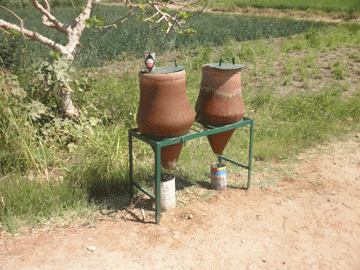
These water filters are at the end of every road in the village, but we haven't figured out how they work. |
|
| The first person I saw in the village was an old woman carrying a huge load of freshly picked greens for the animals. I took pictures as she was walking up the hill in front of me. As I snapped the last one at her door, I heard someone shouting, "No! No!" and saw a young boy running up the hill, shaking his head, waving his arms. Then Charlie gave the woman a coin, and the boy was even more upset. I realized boy's intent and was sorry I had taken the pictures and apologized. He explained very politely that she was his grandmother, and that we shouldn't take her picture. He accepted our apologies and accompanied us on the rest of our walk through the village. His English was very good. He told us he was 16 and had learned English in school. | ||
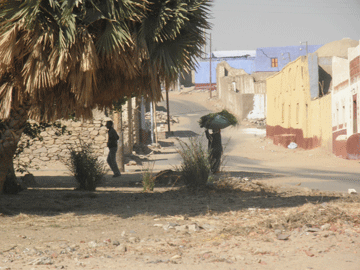 |
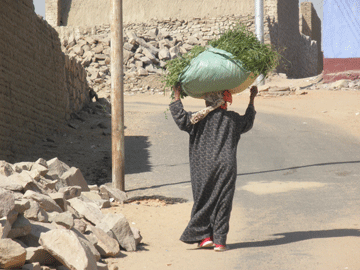 | |
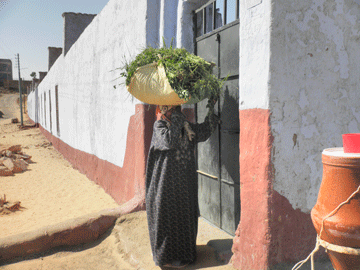 |
||
| Somebody's Grandmother | ||
|
Little children began to gather around us, smiling, staring, the older ones saying "hello," asking where we came from. When we said America, they
seemed especially pleased. They wanted to befriend us, and that's the reaction we have found from people all over Egypt. I asked the boy if I could
take one picture of all the children, and he said no. After that, I never took a picture of anyone, unless I had permission.
Later, Charlie gave a coin to a child that was walking with him, which made the other children ask for one, and, again, the 16-year-old boy said "No." ( I liked this change from what we had experienced in the bazaars surrounding the temples, when little children would come holding up little trinkets, reciting phrases they had been taught to woo tourists, such as "you are beautiful," "I love you," trying to get a tourist to buy a post card or a little doll.) |
||
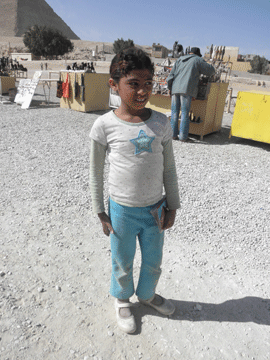 | ||
| I had met this little five-year-old girl at the bazaar in Giza. I asked her where her mother was, and she said, "You are my mother." Her English was amazingly good. In English, she answered every question I asked. She stayed with me the whole time, even out to the street where our van was waiting. I gave her a few coins, and when I looked back she was buying peanuts from a street vendor. | ||
| Back on the boat, we found it was still too windy to sail. We had lunch, and then I wanted to go back to the Nubian village to visit the mosque, which was closed in the morning. Oosha, our captain, and Charlie came with me. I brought my cotton/linen slouch hat that I had knitted to cover my head in case I was able to go into a mosque. Oosha sent for a man with the key to open the mosque, and Charlie and I went in. It was not the "Call-to-Prayer" time, so we were allowed to enter. This mosque, like others we've visited, was a big empty room with no adornments like lighted candles, chandeliers, pews, altars, artwork. Its carpet was plain. The wall were bare. I sat on a chair and prayed that all the good Moslem people would prevail over the fanatics (a word each of our guides used to describe those Moslems using their religion as an excuse for their evil.) | ||
 | ||
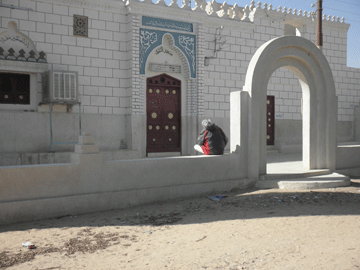
The Village Mosque |
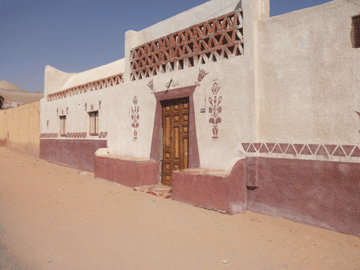
The Village School |
|
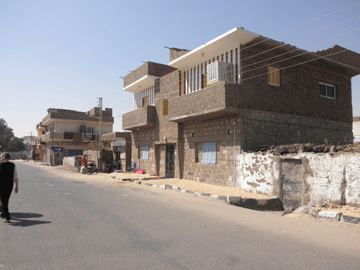
Main Road. The only paved road in the village. | ||
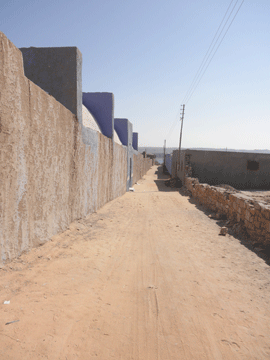 |
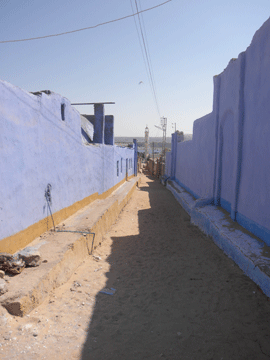 |
|
| Roads within the Village. | ||
| Walking on the main village road back to the boat, we asked a man if there was a grocery shop in the village. He signaled us to follow him, shouted something to someone at the side of the road, and suddenly a big metal door shutter was rolled up, and in a place the size of a one-car garage, were vegetables, fruit, sweets, and some household necessities. We bought some bananas. Unlike the mountain villages we have visited in Greece, where only a few elderly families still live, whose grandchildren visit during August vacation, these Nubian villages are vibrant with young parents and children. A bus takes residents back and forth to the mainland to work and to shop. The farms are thriving. Every village has new homes being built. | ||
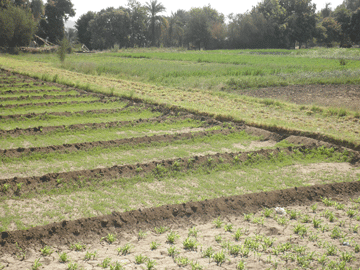 | ||
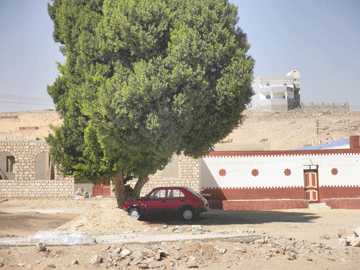 |
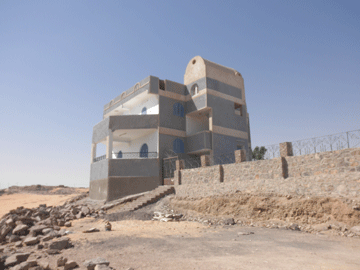 |
|
| Young people come back to their village and build a new home, often to provide a better home for their parents as well as for themselves. The villa on the top of the hill was built by a Nubian man, who grew up in the village, married an English woman and chose spend their lives back in his village. | ||
|
Aswan, Egypt. Day 4 on the Glory of Nubia felucca. Sunday, March 18, 2012
I washed my face in the Nile before we sailed. At Kom Ombo, we said good-bye to the Glory of Nubia and to an unforgettable adventure, an experience of a lifetime. Sometimes the wind wasn't right, the nights were cold, Cynthia and Charlie each had the stomach bug, I gouged my leg on a log, and it was too chilly to take baths in the Nile. But, the food was great, the tea was hot, the crew were wonderful, the Glory of Nubia has a portable toilet, and we did something beyond anything we'd ever imagined. We sailed on a felucca up the Nile River! Wow! |
||
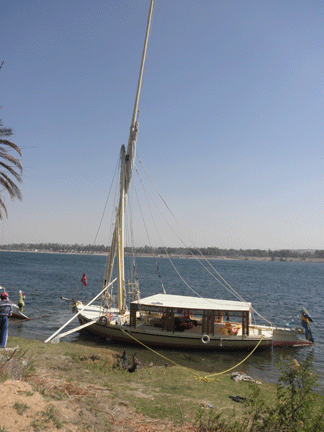
The Glory of Nubia |
||
| In Kom Ombo, we again met our Aswan guide Mohammed, and he took us to the Temple of Kom Ombo, on a promomtory overlooking the Nile. On the walkway toward the temple, Cynthia snapped our last photo of the Glory of Nubia. | ||
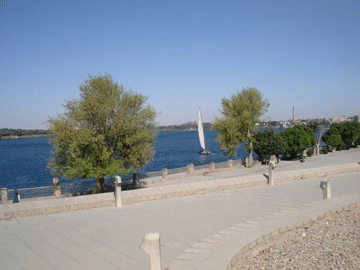
A last look at Glory of Nubia |
||
| The left half of the symmetrical Kom Ombo temple is dedicated to the local god Sobek (the crocodile god) and the right half to Horus the Elder. On display are mummified crocodiles and their clay coffins that were dug up from a sacred-animal cemetery. Nearby is a small pool where crocodiles, the sacred animals of Sobek, were raised. | ||
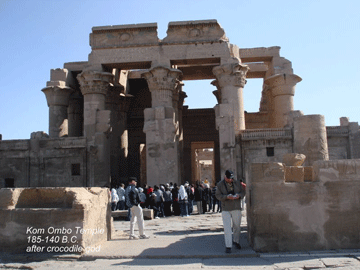
Kom Ombo Temple |
||
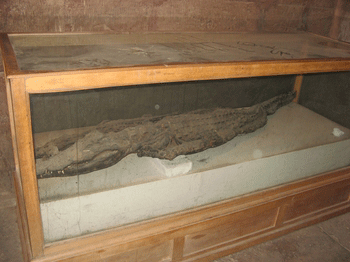
Mummified Crocodile |
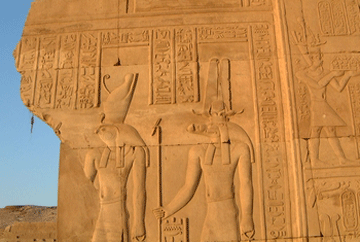
Horus and Sobek |
|
| Later, we went to the Temple of at Edfu, the best preserved
Egyptian temple, where we once again met Horus and another aspect of his myth.
The falcon-headed Horus was originally the sky god, whose
eyes were the sun and moon. He also, as we had learned, was the child
of Isis and Osiris. Raised by Isis and Hathor after Osiris' murder by his
brother Seth, Horus avenged his father's death in a great battle at Edfu.
Seth was exiled and Horus took the throne, Osiris reigning through him from
the underworld. All pharoahs claimed to be the incarnation of Horus, the
"living king." The Temple of Edfu was abandoned after the Roman Empire became Christian and paganism was outlawed in 391 AD. It lay buried up to its lintels in sand, with homes built over the top, until it was excavated by Auguste Mariette in the 1860s. The sand protected the monument over the years, leaving it very well preserved today. |
||
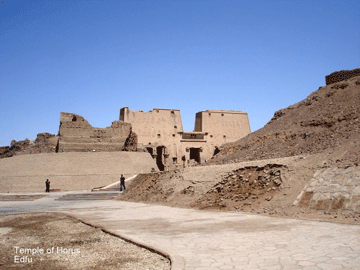
Temple of Horus at Edfu |
||
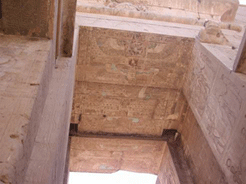 |
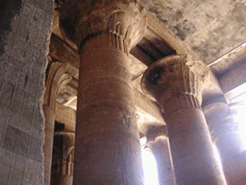 |
|
| TOP | ||
| After Edfu, we went in the van with Mohammed to Luxor. The hotel we had reserved, which was supposed to have Internet access, did not. Since I had been out of touch with my family for a week, I really wanted to check my email. We were in the lobby of that hotel, when Abdu phoned. I told him about my disappointment. He told us to wait and have our van wait and he'd find a hotel that had Internet access. He called back in five minutes and we went to the Lotus Hotel. All I could think of was "What did we ever do to deserve such an wonderful stranger/guide/friend like Abdu?" I had forgotten to ask him if baby Sadn had been born yet. | ||
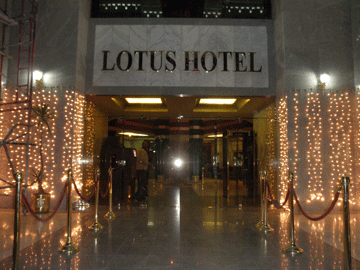 |
||
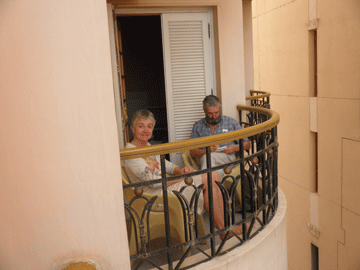 |
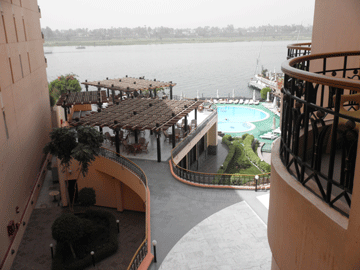 |
|
| Relaxing on their balcony. (I probably was the lobby with my netbook.) | ||
| Luxor. Valley of the Kings. Monday, March 19, 2012 This morning we met our Luxor guide, Ahmed. He took us to the Valley of the Kings, which has 63 royal tombs from 1550-1069. Because the pyramids were easy targets for thieves, this new way of constructing royal tombs was discovered. These tombs are cut into the mountains. Each tomb from the outside looks like an opening to a cave, but each opening leads to corridors, rooms, pillars, statues, carvings on the walls, shrines and burial chambers containing mummies, with their furniture, boxes of jewels and other articles that would be useful in the afterlife. Tutankhamum's tomb, the richest tomb of all, was discovered here in 1922. Although Tut was only 19 when he died, his tomb was crammed with treasures--jewelry, furniture, statues, chariots, musical instruments-which are now in the Cairo museum. In the tomb is Tut's mummy with a gold mask, in a gold coffin. For years it was believed that Tut was murdered by a blow to the back of his head. His mummy showed no such injury, and it is believed that a break just above his left knee that could have become infected was the likely cause of his death. |
||
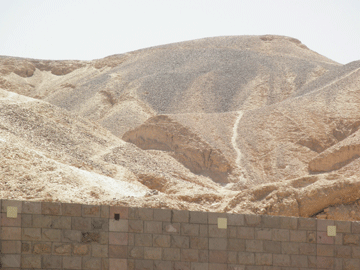 |
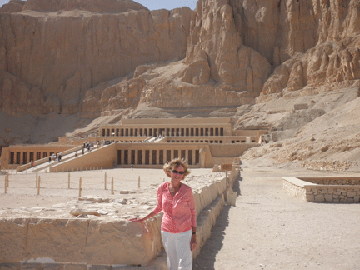 |
|
| Luxor. Temple of Hatshepsut. Monday, March 19, 2012
On the other side of the Valley of the Kings is the Temple of Hatshepsut (pronounced hat sheep suit). She is regarded as one of the most successful pharaohs, reigning for 20 years, longer than any other Egyptian woman Pharaoh. Early in her reign, she was successful in warfare, but then began a long peaceful era. Her reign was also prosperous. She re-established trading relationships lost during a foreign occupation and brought great wealth to Egypt. That wealth enabled Hatshepsut to initiate building projects that raised the calibre of Ancient Egyptian architecture to a standard, comparable to classical architecture, that would not be rivaled by any other culture for a thousand years. |
||
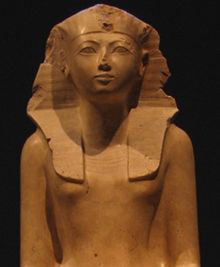
Pharaoh Hatshepsut |
||
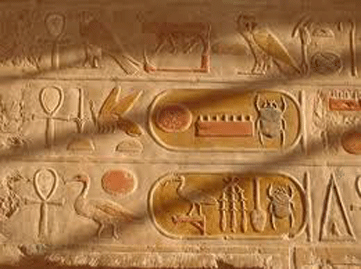 |
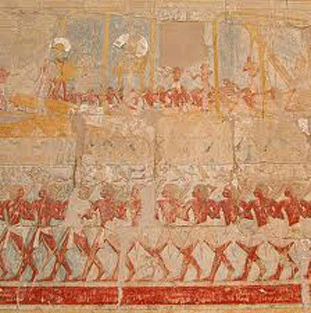 |
|
| The colors are well preserved in these tombs buried in the mountains. | ||
| Luxor. Alabaster Factory. Monday, March 19, 2012
We stopped at an alabaster factory and watched a man making a pot from the alabaster. Then we went inside to see the final products. The friendly man inside served us pomegranate juice. I bought a hand-made alabaster candle-holder. It has a saucer for a tea candle and a dome that you can see through when the candle is lit. I think it's beautiful. Cynthia and Bill were with me. Cynthia bought a King Tut bust of alabaster for her granddaughter. Charlie didn't come with us today because he had been to the Valley of the Kings on his last trip. The manager told Ahmed that I was beautiful and that he wanted to marry me. Ahmed told him I had a husband. I mentioned that I was pretty old. I thought of adding "and not rich" but I didn't want to offend him and ruin the moment. |
||
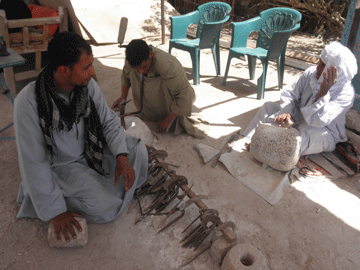 |
||
| Luxor. Temple of Karmak. Monday, March 19, 2012 In the afternoon, we visited the Temple of Karmak in Luxor (ancient Thebes). Every king during Egypt's Golden Age built temples, chapels, and statues, which created the Karnak Temple complex. This temple celebrates the Golden Age of the Pharaohs and was dedicated to the god Amon. For a short time in ancient Egyptian history, a new king decided that Egyptians were to abandon the worship of their gods, including Amon, and worship a single god, Aten, the Sun God, and he built a new temple for his god inside Karnak. However, when Tutankamon became king at the age of nine, he reestablished the political and religious power at Thebes and reinstated the priests of Amon. |
||
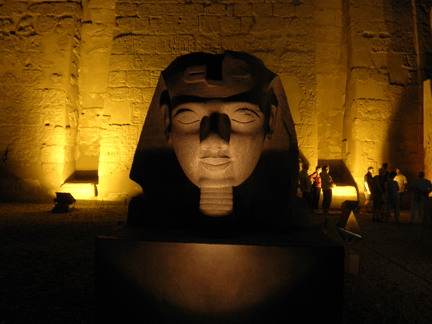
King Tutankamon |
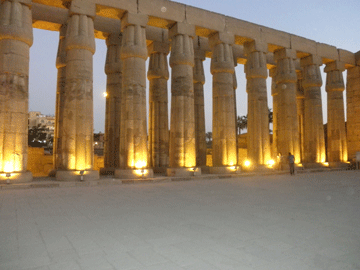
Pillars of the Great Hyprstyle Hall |
|
| To reach the temple, you have to go through the large tourist bazaar. On the one hand, you have to feel sympathy for the merchants desperately trying to attract the few tourists visiting Egypt now. On the other hand, you have to keep saying "la, shukrran" (no, thank you) or "ana ma beddy" (I don't want any) and when you really get desperate "la fish feluss" (I have no money). | ||
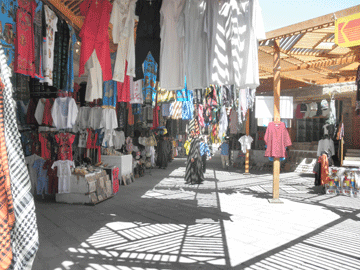 |
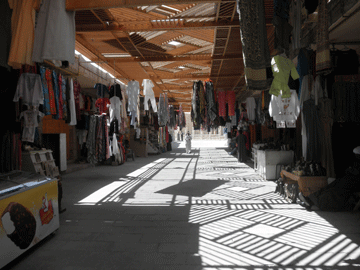 |
|
| In the evening, Cynthia, Bill, Charlie and I went back to Karnak presentation, in English, of the Karnak Temple Sound and Light Show. We arrived after sunset and walked, to music and narration, down the entrance between the ram-headed sphinxes, through the Great Hypostyle Hall, to the Sacred Lake, where we sat in stadium seats and watched as each narrated part was accented by music and theatrical lighting. It was a both a tour through ancient Egyptian history and a review of our beautiful day with Ahmed in ancient Egyptian temples. | ||
| On the Road to Abydos and Dandara Temples. Tuesday, March 20, 2012
We went with Ahmed to Abydos (Land of the Heart). On the way, we passed through many kilometers of sugar cane farms. When we stopped at a red light and showed interest in the sugar cane stalks piled in the back of a truck, a passer-by grabbed a stalk from the truck and handed it to us through the van window. Ahmed peeled it for us, and we all sucked on the sweet sugar cane. | ||
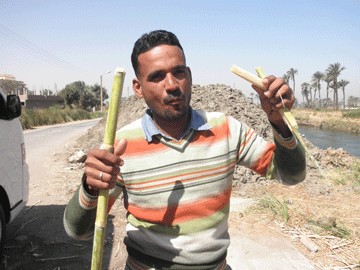 |
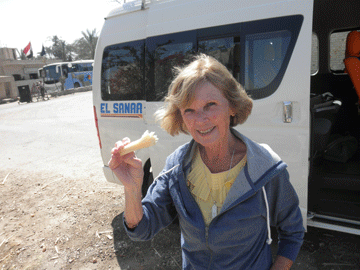 |
|
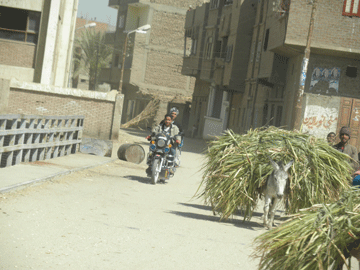 |
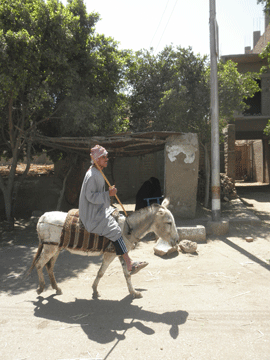 |
|
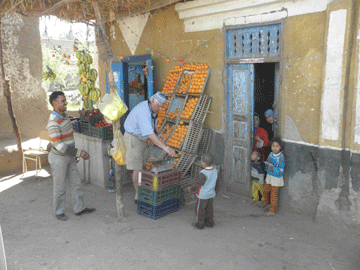
Buying Oranges |
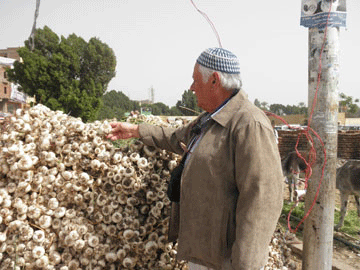
So much garlic! |
|
| Abydos. Tuesday, March 20, 2012
Abydos is located in the main cult center of Osiris, god of the dead, and includes the tomb of Osiris. We know his story well by now. He was murdered by his jealous brother Seth, who tricked Osiris into climbing in a chest, which he then sealed and threw into the Nile. His wife Isis retrieved his body, but Seth seized it back, dismembered it, and scattered its parts all over. Isis collected all the parts and brought him back to life long enough for her to conceive Horus, her son. While Horus ruled on earth, his father Osiris ruled as god of the afterlife. He came to represent the hope for salvation after death, which was an important belief for ancient Egyptians. |
||
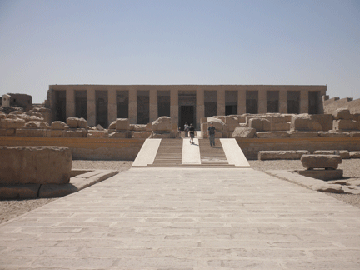
Abydos Temple |
||
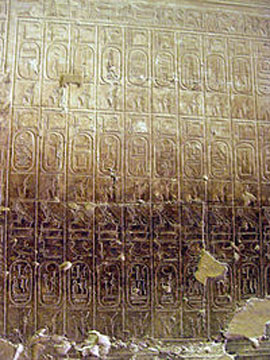
Cartouches of Kings |
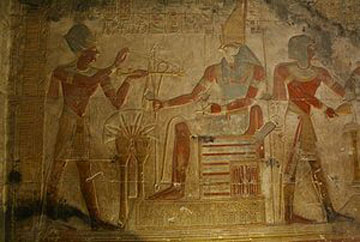
Horus offering a gift to a visiting Pharoh |
|
| After that we went to Dandara Temple in Qena. It is the Temple of Hathor, the goddess of love, patron of music and dancing, and as "Lady of the West," she was the protector of the dead. She was also a maternal figure and wears a headdress of cow's horns. The colors on the walls are exceptionally well preserved. | ||
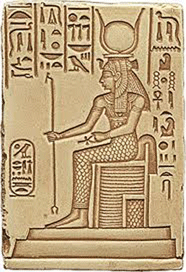
Hathor, Goddess of Love |
||
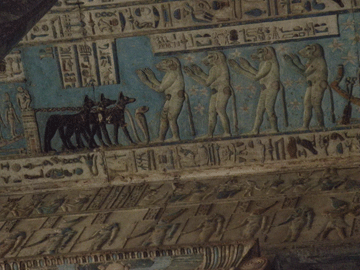 |
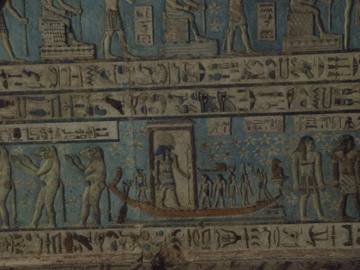 |
|
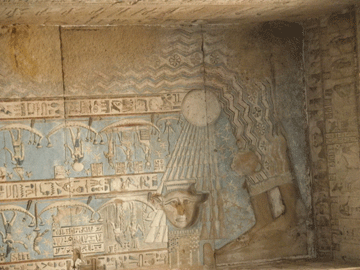 |
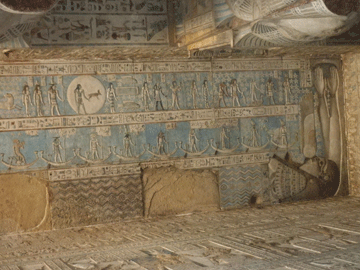 |
|
| On the way home to Luxor, we stopped at a papyrus factory, and watched how paper is made from the papyrus plant. We all came out with purchases. Charlie and I bought two painted-on-papyrus wall hangings. One has two cartouches, a Bette and a Costas cartouche with our names in hieroglyphics. The other, grandson Charles's 12th birthday gift, has wings to fly around the world and a scarab for protection. | ||
| Luxor Today. Monday, March 19, 2012
Luxor is a unique and beautiful city, with the Nile river flowing between the modern city and the ancient Valley of the Kings on the West Bank. The temples of Karnak and Luxor scattered across the town make Luxor seem like an open-air museum. In the afternoon, Cynthia, Bill, Charlie and I took a walk around modern Luxor, stopping at the Winter Palace Gardens. | ||
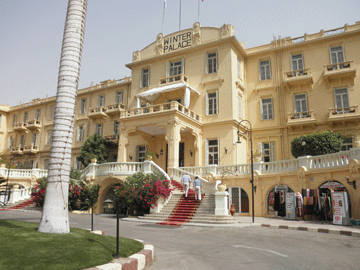 |
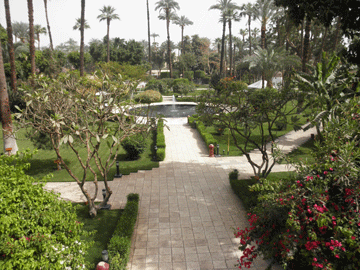 |
|
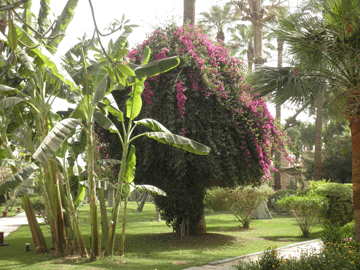 |
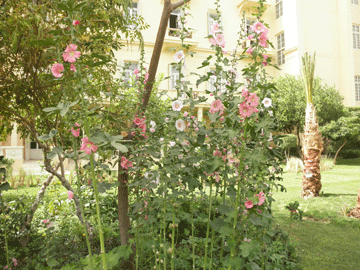 |
|
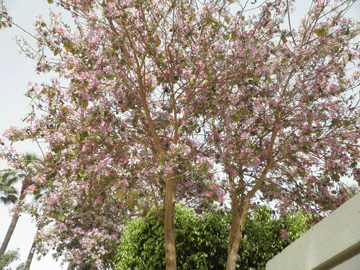 |
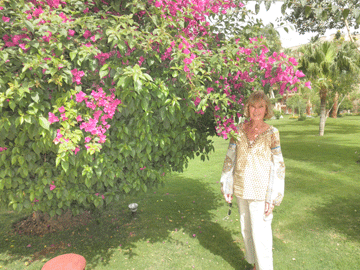 |
|
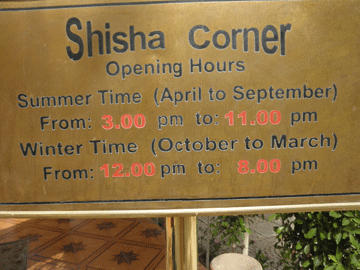 |
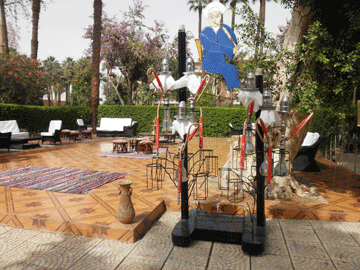 |
|
| We had dinner at the Tutti Fruitti restaurant, on a side street a block from the Lotus Hotel. It was suggested to us by a woman I met in the hotel lobby as we both were taking advantage of the hotel's WiFi. She and her husband are Dutch, from a town close to Roermund, where we used to shop on Saturdays when I lived in Kehrbusch, Germany. The restaurant is owned by a British woman who has lived in Luxor for many years,and has recently turned her tea room into a restaurant. The food was excellent, expecially my chicken covered with sesame seeds. | ||
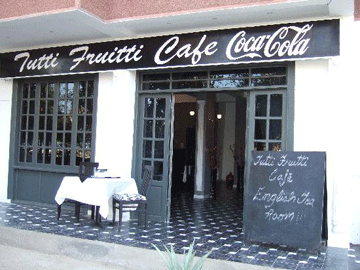 |
||
| A Day With Ahmed's Family. Wednesday, March 21, 2012
We were very excited. Ahmed had invited us to his home. He met us at our hotel at 9:00 a.m. We walked with Ahmed to the bus station for a mini-bus, Egypt's version of Tanzania's "dahla dahla," that would take us to his farm. Ahmed had said he would pick us up with a taxi, but we wanted to take the bus. | ||
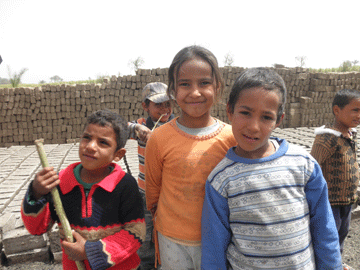 |
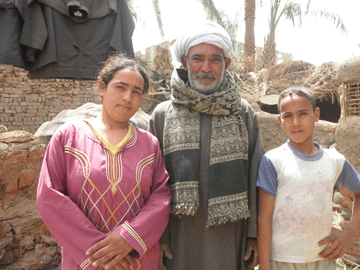 |
|
| The visit was a highlight of our trip. We first went to the fields where his father (Abdulla) was working. He wore a turban
and a galabia, and came to greet Ahmed and his guests with a big smile. After showing us around the field, which Ahmed and his brother had planted,
we went to their home.
Inside, we met his grandmother, his mother, his aunt, and his fiance, Anyat. Everybody greeted us warmly, with smiles and nods. Two birds watched from the rafters. His grandmother sat on a couch, the children stood nearby staring at the strangers, and Ahmed's mother and aunt came with fruit drinks. Ahmed aksed where his fiancé (Anyat) was and was told she was doing laundry. Ahmed said she was shy. She eventually joined us, staying just a little while. We met her a little later outside, helping Ahmed's mother make bread. |
||
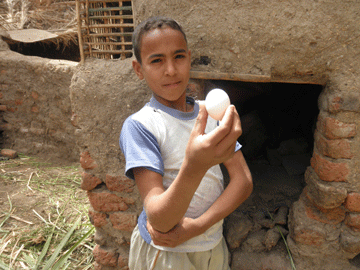 |
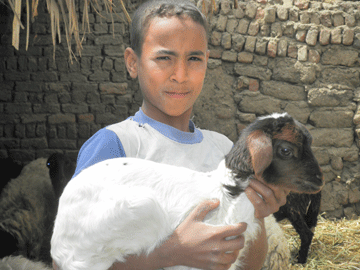 |
|
| Mubarak, 12 years old, was a most gracious, helpful, host. He stayed right with us, guiding us on our tou around the village. I think someday he'll go to university and be an excellent tour guide like his cousin Ahmed. | ||
| Then we were given a tour around the farmyard, picking up children as we went. Mubarak was with us the whole time, ready to help. We saw two men on the farm making mud bricks, and we visited the donkeys, cows, chickens, goats, and lambs. We also watched Anyat and Ahmed's mother making bread. About 30 uncooked loves of bread, each on a round, flat stone were rising in the sun. Meanwhile the women were getting the fire ready. | ||
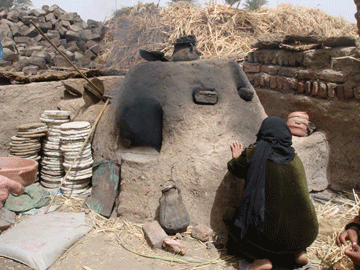 |
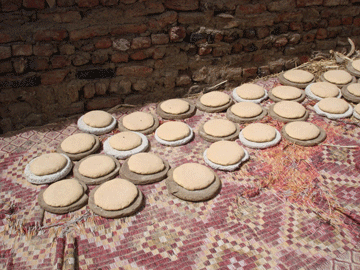 |
|
| Baking Bread | ||
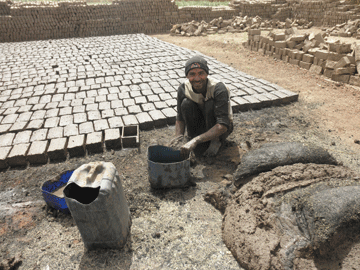
Making Mud Bricks |
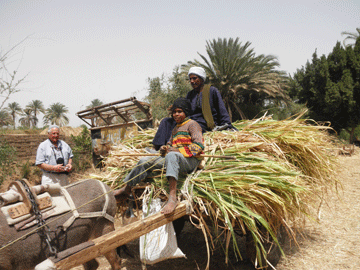
Harvesting Sugar Cane |
|
|
When it was time for lunch we went back inside to a table laden with a variety of different delicious dishes. The children stood around watching,
and when we were finished Mubarak and Oala cleared the table. Later we saw all the young children eating their lunch together at a low table in a
different room.
Ahmed is the third oldest of 12 children. His fiancé Anyat is his first cousin. His father and her mother are brother and sister. Ahmed told us how he saved her life when she was four and he was ten. She had fallen into the stream that runs in front of their house, and he jumped in, picked her up, and carried her to her home, chastizing her mother for being a bad mother, not watching her child. At that point, his grandmother told him to mind his tongue because that mother would someday be his mother-in-law. In this village live seven of Ahmed's uncles and their families. Ahmed graduated from a university with a major in tourism. He told us that he loves his job as tour guide, but also loves the farm. He wants to spend his life in both worlds. His oldest brother is a doctor, the next brother a lawyer, and his younger sister is studying to be a tour guide like Ahmed. I think his father deserves credit for his educated children. "Look at me, with no education," he told them. "I don't want you to be like me. Ahmed's father told him, "Teaching small children is like writing on stone; teaching teenagers is like writing on water." Words of wisdom. I think he taught his young children very well. | ||
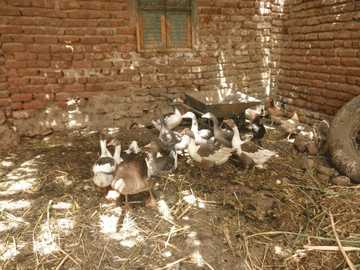 |
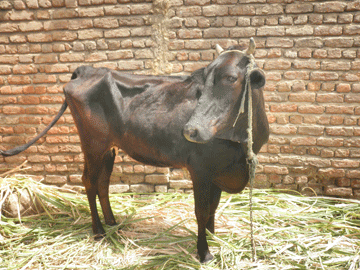 |
|
| After lunch, we walked to the Mosque. Oala gave me her headscarf, but since it was Call-to-Prayer time, we couldn't go inside. When I tried to return Oala's headscarf, she shook her head, indicating that she wanted me to keep it. A few minutes later, Mubarak came to Cynthia and me with two headscarfs. He handed the one I had worn to me and the other one to Cynthia. When, before the visit, we had asked Ahmed what we could bring to his family, he said food. Charlie wanted to bring chickens, but I had a different idea, which Cynthia and Bill liked. At one point, I told Ahmed that my daughter had given us the round-trip tickets to come to Israel. He said that his parents had one wish, to go to Mecca, and his goal was to give them the money for that trip. Instead of chickens, we were happy to give Ahmed a little gift to help him reach his goal of bringing his parents to Mecca. | ||
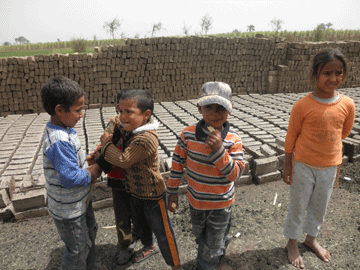 |
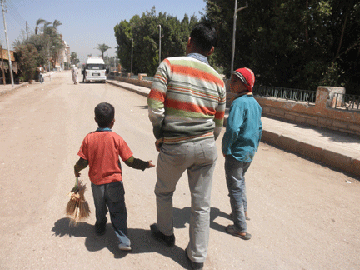 |
|
| TOP | ||
| On our last evening in Luxor, we had dinner at Sofra Restaurant. Like the other restaurant in Luxor, it was very good, but everybody dining there was a tourist, none, however, from the United States. Tomorrow we're leaving African Egypt, where we have not met one American tourist. | ||
| Ahmed came to our hotel at 8:45 a.m. with a taxi and we went to Luxor Airport for our 10:30 flight to Sharm el-Scheikh. It was sad leaving Ahmed. I am sure he will meet my grandchildren who I know will someday come to Luxor. We will never think about Luxor without thinking of Ahmed. We told him that he and anyone of his family who comes to the United States will always be welcomed in our homes. | ||
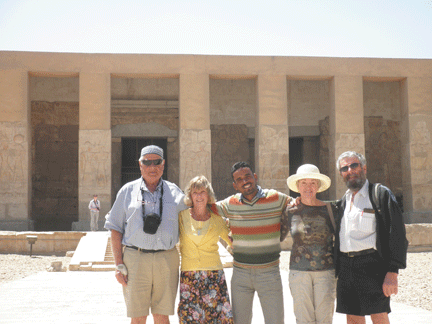
We love Ahmed! We love Luxor! We love Egypt! |
||
| Dehab. Thursday, March 22, 2012
Instead of taking one of the fine-looking taxis lined up at the Sharm el-Scheikh airport, Charlie decided that it would be a good time to experience bus travel. So we got a taxi from the airport and Charlie told the driver to take us to the bus station. The taxi driver looked at us as if we were crazy. "The bus station?" he said and assured us he would drive us all the way to Dahab, which Cynthia and I thought was a good idea, since we had read in the guide books that bus travel in Egypt was unreliable. When we got the bus station, it was run-down, in the middle of nowhere, practically deserted, and we didn't see any buses. It was 11:30 a.m. and we were told that a bus would probably go to Dahab at 3:30 p.m. There were no taxis in sight. We were standing in front of the station, wondering what to do, when an old beat-up car stopped. A man got out, took off his cap, replaced it with his Egyptian headscarf, opened the trunk and motioned for us to bring our stuff. We sqeezed into his grimy car and endured our ONLY unpleasant experience in Egypt. He drove like a maniac, screaming into his cell all the way. We sped along for 2 1/2 hours listening to the fender scrape the tire every time he turned a corner. When we had to stop at checkpoints, he would get out and scream at people. We were afraid they were going to arrest him and leave us stranded, or worse. Each time, we breathed sighs of relief when we got moving again. But then, suddenly, like a mirage in the desert, to our right, rising out of the desert, appeared a palm-tree-lined drive. He turned into it and stopped at the Mecure Dahab Bay View Hotel, and, to our great joy and relief, it was ours, the one we had reserved, sight unseen, online. |
||
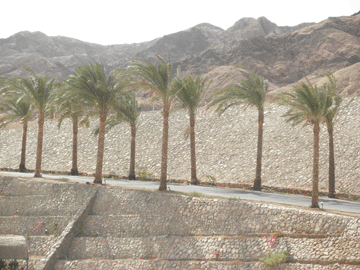 |
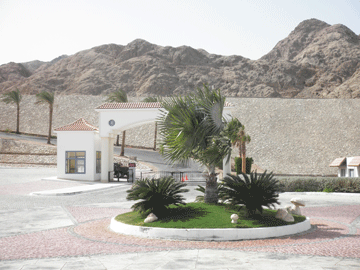 |
|
| This hotel resort, built on the mountainside has descending rows of white duplexes, leading down to the Red Sea. It turned out to be just as wonderful as it looked. Cynthia, Bill, and I loved it. Charlie didn't like it. It wasn't in the middle of a city where he could walk around. He said he feels trapped in places like this. | ||
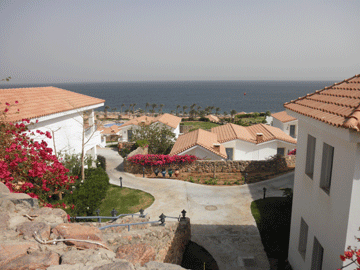 |
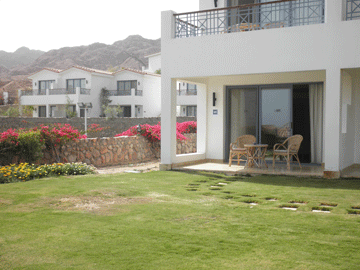 |
|
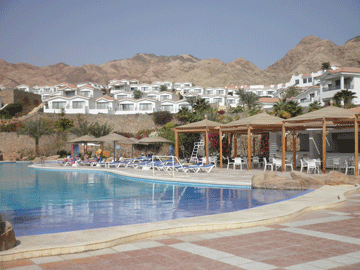 |
||
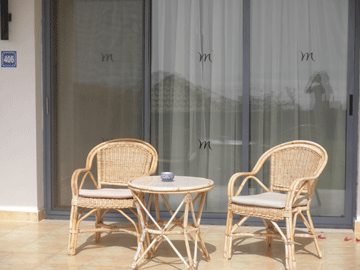 |
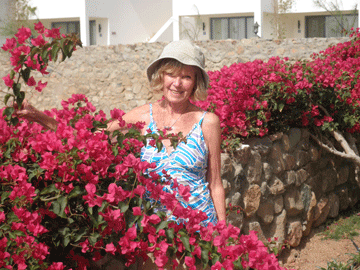 |
|
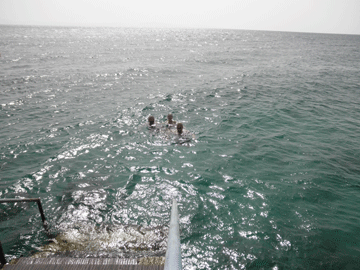 |
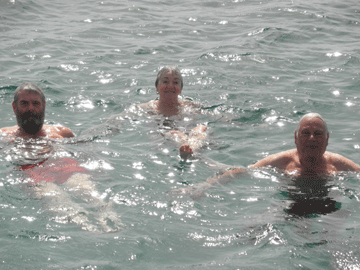 |
|
| This hotel also has the Red Sea, which Cynthia, Bill, and Charlie enjoyed. The water was too cold for me. The hotel had free shuttles twice a day going back and forth to Dahab, and it was only a 15 minute taxi ride. The first night, Charlie and I took a taxi into Dahab for dinner. We ate at the Ali Baba Restaurant, right on the Red Sea. The whole dining room is outside, with Arabian-style curtains that they close if the sea breeze gets too cool. The cushioned seats, the pillows, the rugs, the exotic lanterns recreated for us the Arabian Nights. The food was excellent. It was a very pleasant evening. Our taxi was waiting to take back to our hotel. | ||
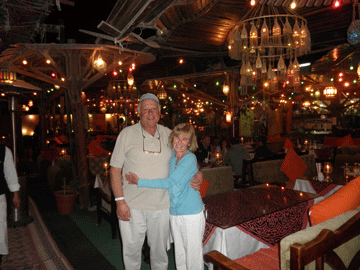 |
||
| Dehab. Friday, March 23, 2012
In the morning, we all took the shuttle into Dehab. Charlie wanted to search for the hotel he'd stayed on his 34 years ago visit to Dehab. We found it, and it was quite luxurious. Back on the Dehab beachfront, we had lost Charlie, so Cynthia, Bill, and I were walking along the street when we met a little boy crying "MaMa." We could not understand his language, but we did not want to leave him alone. A passer-by told us the language was Russian. We tried to comfort him and walked with him in the direction he was going for a little while. Then, thinking his parents must be somewhere behind him, we got him to retrace his steps. We went with him, looking into every restaurant and bathing platform on the Red Sea side. Finally, a woman signaled that he belonged on her bathing place. At first, we thought she was his mother, but she pointed to another young woman in a bikini sunning. The little boy ran to her, crying "MaMa." She looked blankly at us, and showed no emotion. She didn't hug him. She seemed unaware that her son had been missing, and she showed no joy at his return. A far cry from helicopter parents and the child-centered world at home. In the afternoon, Charlie and I took the 3:30 hotel shuttle back to Dehab, and did a little shopping. We bought harem pants for the girls and a duffle bag to carry our purchases home. We had room service for dinner. |
||
| St. Katerine's Monastery. Saturday, March 24, 2012
Abdul, our guide from Dahab, took us to St. Katherine's Monastery. Outside it is quiet and peaceful with paths and gardens and spring flowers. It is one of the oldest functioning monastic communities in the world and its chapel is one of Early Christianity's only surviving churches. The original chapel was built by the Roman Empress Helena in 330 AD beside the Burning Bush from which God spoke to Moses. In the 6th Century Emperor Justinian ordered a fortress to be constructed around the original chapel, together with a basilica and a monastery. The monastery was named after St. Katherine of Alexandria. We were able to see the beautiful Byzantine icons in the monastery museum and go into the Church of the Transfiguration and see the 6th Century mosaic of the transfiguration of Christ. Because Charlie spoke Greek to the priest, we were invited to view the St. Katherine relics, where we each received a blessing and a ring from the priest. My friend Kathy (from my Vero Beach Tuesday night movie group and also from St. Nicholas Greek Orthodox Church) had told me, when she heard I was going to St. Katherine's, that she hoped to go back there someday. So I bought a St. Katherine icon for her, which the priest blessed for me. I said a prayer that Kathy would return to St. Katherine's. |
||
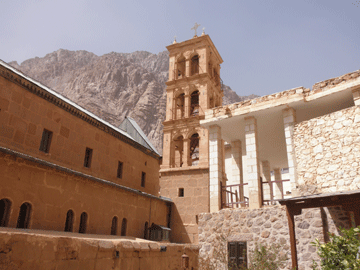 |
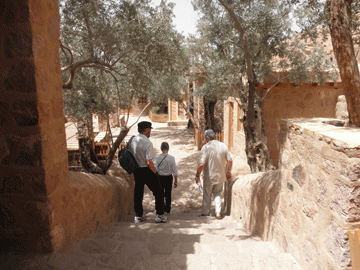 |
|
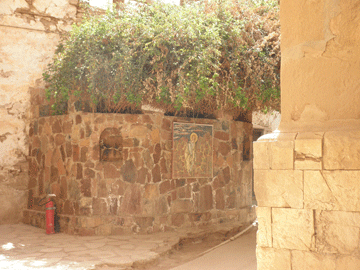 |
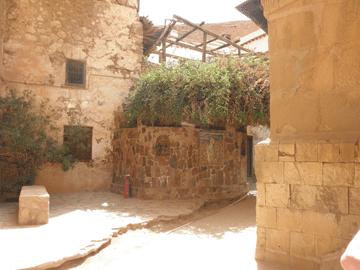 |
|
| The Burning Bush | ||
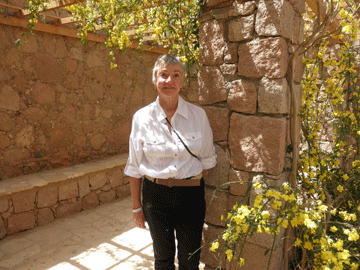 |
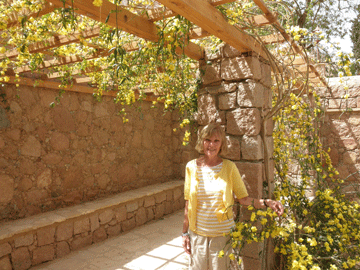 |
|
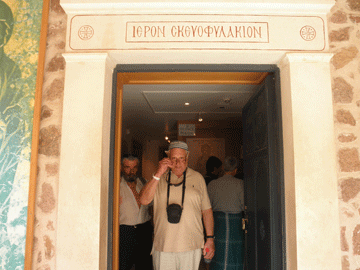 |
||
| We couldn't linger too long at St. Katherine's because we were eager to begin the climb to the top of Mt. Sinai. Cynthia and I had made this our goal when we first started planning our trip. Cynthia's birthday was the next day, and this was her birthday present to herself. I was determined to get to the spot where God gave Moses the Ten Commandments. Bill didn't make such a big deal about it. He just climbed the mountain. | ||
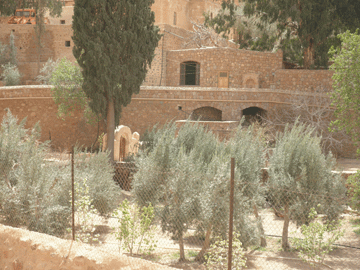 |
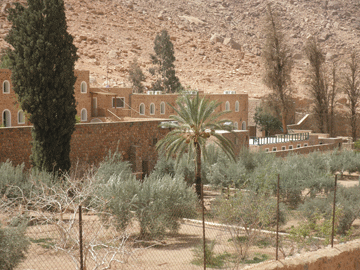 |
|
| From St. Katherine's to Mount Sinai | ||
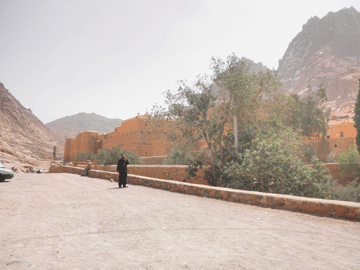 |
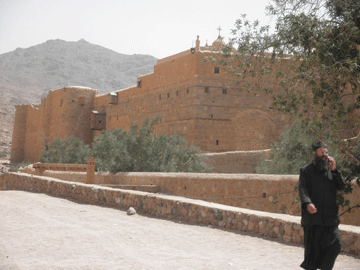 |
|
| The Road to Mount Sinai | ||
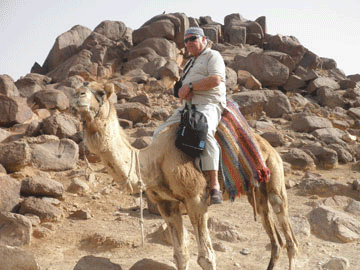
Walking might be easier. |
||
| Climbing Mount Sinai, March 24, 2012 I put on my new sneakers and my hat and started walking up the hill toward the mountain behind Cynthia and Bill, with Charlie following on a camel. We took the "camel trail." After thirty minutes, I was having trouble breathing, and that made me nervous, but after another thirty minutes the breathing was all right and my feet were killing me, and that made me nervous. I asked our guide, Hassan, if I would make it to the top. He said, "I don't know." But after that, I forgot about my breathing and my feet and just concentrated on what rock I would put my foot on next. Later I asked Hassan again if he thought I would make it to the top and again he said, "I don't know." I kept on putting one foot in front of the other, carefully picking each stone, and stopping to rest at each Bedoin refreshment stand along the way. The trail up the mountain varies from gravelly places to rocky patches to steps of steep boulders. At 300 meters below the summit you reach a plateau with friendly Bedoins selling tea and soft drinks. There's a tent with couches and blankets. Everything for a weary climber. We, however, were too focused on our goal to rest here. The camel doesn't go any higher than this, so this is where Charlie waited for us. This is also where the 750 steps to the top begin. They're not steps. They're only called steps. Each "step" is a giant boulder, placed unevenly, and you have to look carefully to find the right one that keeps you on the unmarked trail. The third time I asked Hassan if he thought I'd make it, he said, "Maybe." That was good to hear. I could always see Cynthia and Bill ahead of me, which was reassuring. Bill carried water in his backpack. And, from time to time, Cynthia would call out words of encouragement. When I actually could see the top, I asked Hassan for the last time if he thought I would make it to the top, and he said, "You'll make it." And I did! Cynthia, Bill waited for me, and we got to the top together. I'll never forget that moment or that feeling. |
||
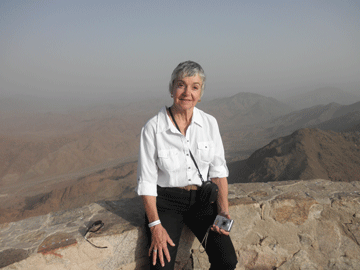 |
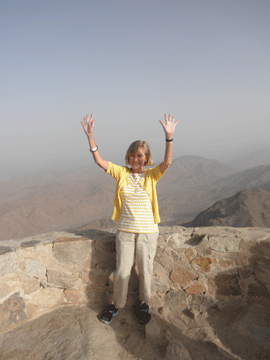 |
|
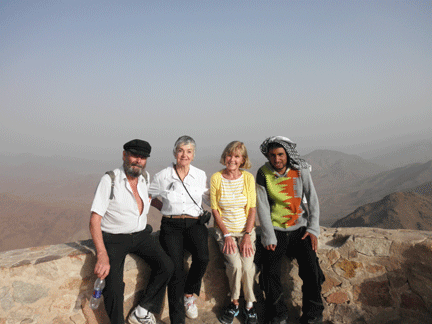 |
||
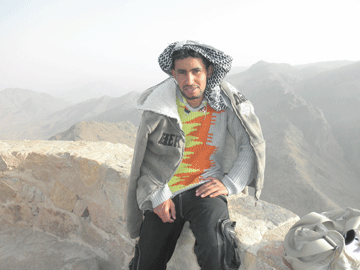 |
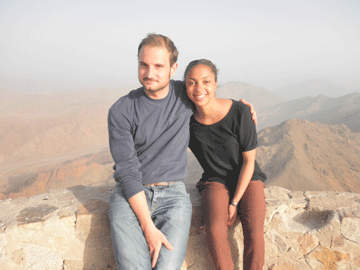 |
|
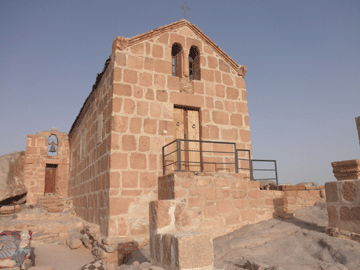 |
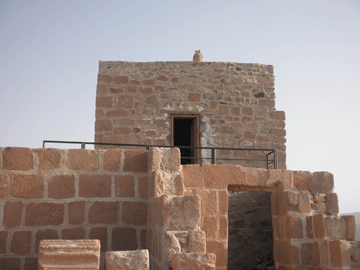 |
|
| A young couple got to the top right after we did. They had started out with five others, who all dropped out along the way.
We took some time to look around and down at the awesome views and took some pictures of where we had been and of the old chapel and mosque
at the top. The young couple were waiting for sunset, but we didn't want to be making our way down in the dark.
When we reached the bottom of the 750 steps, we found Charlie sleeping on a couch in the Bedoin tent. The Bedoins were congratulating us and made me a cup of tea. The little camel boy was still there. Then the four of us began the long trek down, as the sun was setting. It was very dark when got to the bottom of the mountain, down to St. Catherine's and to the café where our driver Abdul was waiting. What an awesome day! | ||
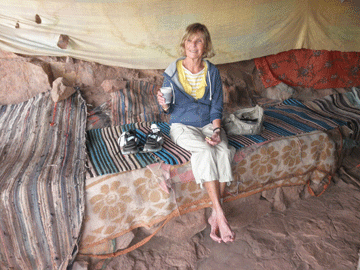
A cup of tea |
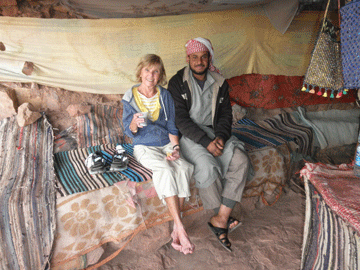
and a new friend. |
|
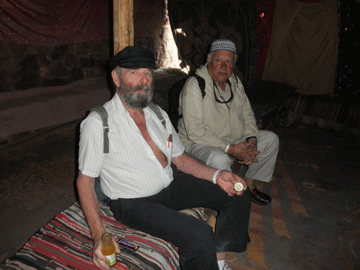
Bill and Charlie in the Bedoin Tent |
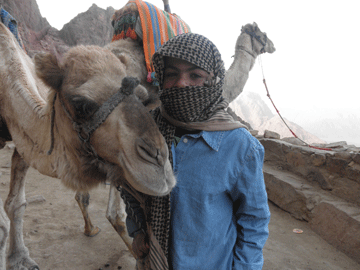
Charlie's 12-year-old camel guide |
|
| Abdul drove us from Dehab to the Port of Neweiba. We had been given various times for the ferry to leave for Aqaba, Jordan
so, to be cautious, we left Dahab on time for the earliest possible departure. It was a good thing! We just had time to buy our tickets and join the line
already forming to board. We seemed to be the only foreigners and the only tourists. As we inched along in the line of mostly men, surprisingly, people
would motion to us to go ahead, something that doesn't happen in lines at home. An official approached us, told us to follow him, and he took us to the
front of the line. Instead of everyone giving us dirty looks for cutting, as they would back home, people in line smiled and nodded approval. We were
then ushered onto the boat, the first passengers to board. We shouldn't have been surprised. This is the way we had been treated throughout Egypt.
It was sad leaving Luxor. It was sad leaving Egypt. And, as tourists, we had the country and its hospitable people all to ourselves. We felt safe. We felt welcomed. Egypt now has a place in my heart. What happens there matters to me. |
||
| TOP | ||